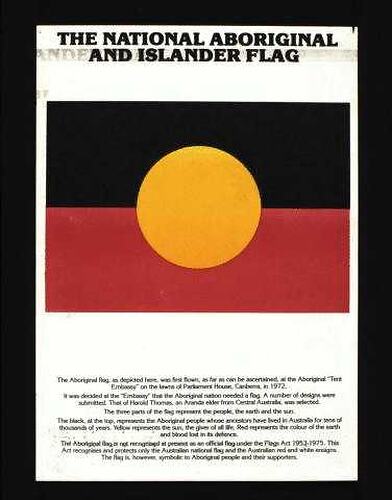Summary
Poster featuring the Aboriginal flag and a description of its history and symbolism. According to the poster's explanatory text: 'The Aboriginal flag, as depicted here, was first flown, as far as can be ascertained, at the Aboriginal 'Tent Embassy' on the lawns of Parliament House, Canberra, in 1972. It was decided at the 'Embassy' that the Aboriginal nation needed a flag. A number of designs were submitted. That of Harold Thomas, an Aranda elder from Central Australia, was selected. The three parts of the flag represent the people, the earth and the sun. The black, at the top, represents the Aboriginal people whose ancestors have lived in Australia for tens of thousands of years. Yellow represents the sun, the giver of all life. Red represents the colour of the earth and the blood lost in its defence. The Aboriginal flag is not recognised at present as an official flag under the Flags Act 1953-1975. This Act recognises and protects only the Australian national flag and the Australian red and white ensigns. The flag is, however, symbolic to Aboriginal people and their supporters.'
It was later ascertained that the Aboriginal flag was first flown at Victoria Square in Adelaide, South Australia, on National Aborigines Day, 12 July 1971 before it became the official flag for the Aboriginal Tent Embassy in Canberra in 1972. The flag became widely recognised as a symbol of the unity and identity of Aboriginal people. This recognition resulted in its legal acknowledgement by the Commonwealth Government and in 1995, the Aboriginal flag was proclaimed a 'Flag of Australia' under the Flags Act 1953.
Physical Description
Colour ink on textured card. Features Aboriginal flag and black printed text.
More Information
-
Object/Medium
Poster
-
Number of Sheets
1
-
Number of Pages
1
-
Overall Dimensions
295 mm (Width), 420 mm (Height)
-
Designer
Harold J. Thomas
Harold Thomas was the designer of the Aboriginal flag. In 1997, the Federal Court recognised Thomas as the author of the flag. -
Keywords
-
Type of item
-
Discipline
-
Category
-
Collecting Areas
Ethnohistory, Australian Indigenous Identity and Contemporary Life
Title
National Aboriginal and Islander flag
